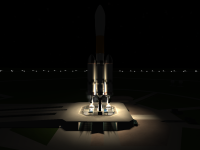
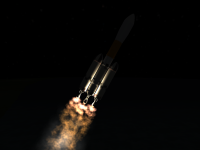
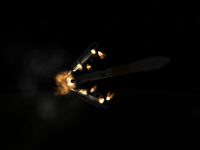
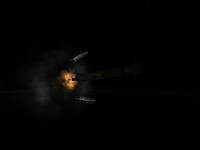


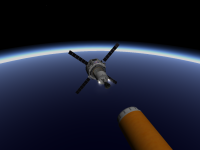
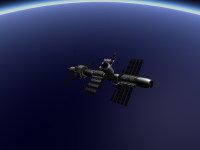
TLF-1 was a lunar fly-by (near free-return) using the Delta Taxi (callsign "Wayfarer") in conjunction with the Napier 2 spaceplane (mission NTF-6). The multiple-launch architecture also involved a CDEDS and made use of the Lagrange Space Station in LEO at 400km/28.6° (which was launched in pieces some three years earlier, and whose name has nothing to do with Lagrange points because I don't play with Principia).
Apart from the complexity of the architecture, the mission is mainly noteworthy for two reasons:
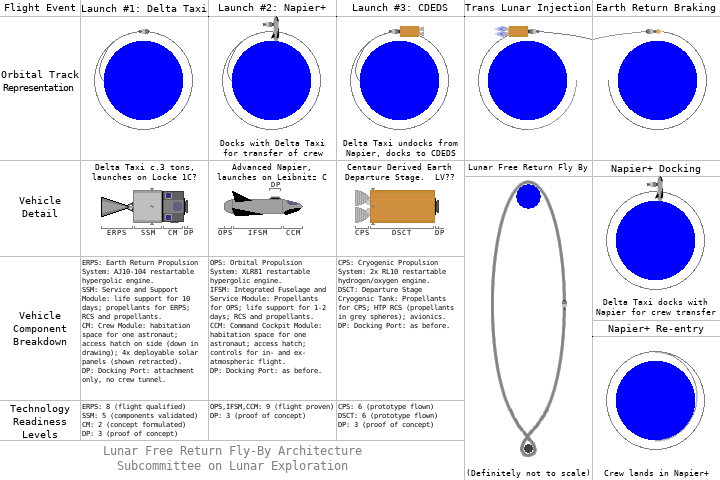
The original CONOPS diagram, prepared 3½ in-game years earlier (does not show space station as that hadn't been built yet).

Final CONOPS diagram for this A-class lunar flyby mission (does not show space station as it's hard to draw).
The Delta Taxi "Wayfarer", a one-man spaceship with 3,600m/s of ΔV (through its AJ10-138 ERPS) and no atmosphere capability, launched on the 12th of February 1964, atop a Leibnitz DE5. The Leibnitz family is a parallel-staged LV utilising an LR105-NA-7.1 sustainer and a pair of H-1 boosters (earlier versions used LR79s); the DC/DE variant uses a Centaur upper stage with a single RL10A-3-3 engine.
 |
 |
 |
 |
| Lift-off of Leibnitz DE5₂ | Passing through Max-Q | Dropping the H-1 boosters | Fairing separation |
 |
 |
 |
 |
| Dropping the sustainer | Parking orbit reached | Deploying the payload | Docking at the Station |
Napier 2, a two-man spaceplane with 2km/s of orbital insertion/manœuvring capability from its XLR81-BA-13 engine, launched for the seventh time on February 20th, 1964, on the Leibnitz DH8 booster. The Leibnitz DH series is similar to the DE that launched Wayfarer, but omits the upper stage as the Napier spaceplane is its own upper stage. It also has four large fins to ensure controllability on ascent despite the wing area of the Napier further forward.
The crew of the Napier were Arkady Lukashenko (pilot) and Brian Newman (passenger). Brian, entrusted with the lunar fly-by, is a veteran on his third spaceflight, but this is Arkady's first mission. Napier operations are thoroughly routine, though; the sister vessel, Napier 1, made nine flights as a single-seater before being rebuilt to two-seat standard and flying twice more; thus this is the 18th time we've launched a spaceplane and by now we know how to do it.
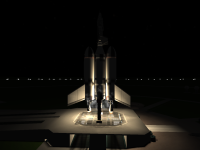 |
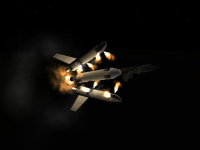 |
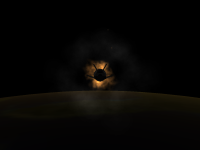 |
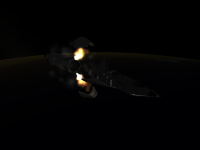 |
| Lift-off of Leibnitz DH8 | Separation of the boosters | Continuing on the LR105 | Dropping the spent sustainer |
 |
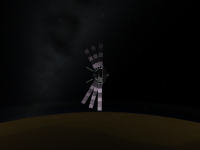 |
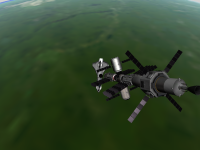 |
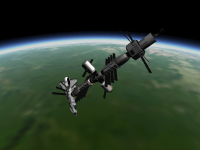 |
| Orbital insertion by XLR81 | In the phasing orbit | Approaching the Station | Docking achieved |
CDEDS 1 launched atop Euler A*6 on the 21st of February 1964. The Euler heavy-lift rocket consists of a four-H-1 'Volta' stage with a single J-2 powering the 'Eulerian' upper. The A* variant is upgraded with the 225klbf nominal J-2 (Eulerian B) giving reduced gravity losses. The CDEDS itself is a simple single-engine hydrolox stage (RL10A-3-3) with just over 7 minutes' propellant (including a large LH₂ surplus to allow for boil-off) and a small docking port, covered during launch by fairings.
The Eulerian is designed to reach orbit and remain attached to the payload during phasing manœuvres, transferring its own residual propellants to the payload to replenish the latter's boil-off losses.
 |
 |
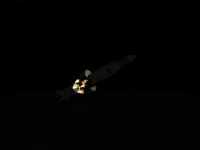 |
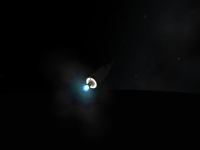 |
| Lift-off of Euler A*6 | Maximum dynamic pressure | Volta burnout and staging | Eulerian carries on |
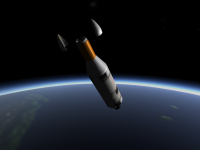 |
 |
 |
|
| Deploying the fairings | Separating the payload | The CDEDS in orbit |
The CDEDS arrived at Lagrange Space Station later on the 21st (some 7¼hrs after launch), at which point Brian Newman EVAed across to Wayfarer (the small docking ports used at Lagrange do not support internal crew transfers), undocked it and flew to meet the CDEDS. The 3.1km/s trans-lunar injection burn followed some ten minutes later; acceleration was low, ranging from less than 0.6g at the start to 1.16g at shutdown nearly seven minutes later, but that's just as well as Brian was experiencing it in the -Z (i.e. upside-down) orientation. (I dunno, maybe he got out of his chair and sat on the ceiling during the burn.)
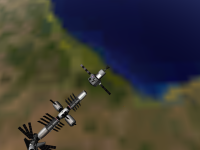 |
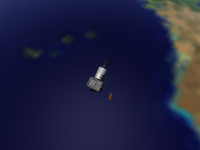 |
 |
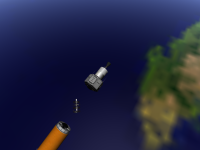 |
| Undocked from Station | The CDEDS in sight | Getting closer | Lined up on the target |
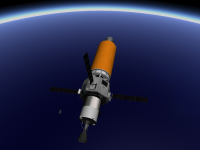 |
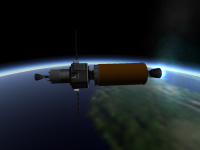 |
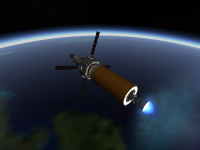 |
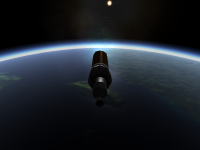 |
| The stack assembled | Beginning TLI | Passing the Station | Mounting velocity |
The journey to the Moon takes over 2½ days; Brian amuses himself by looking out the window, watching Earth recede and the Moon approach.
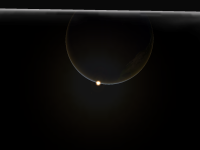 |
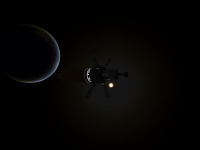 |
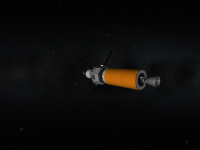 |
| Sunrise out the window | Higher than man has ever been | The Moon looks small from here |
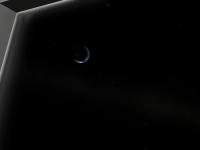 |
 |
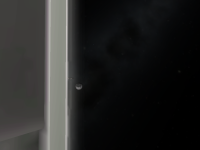 |
| The Earth looks dinky too now | Moon getting nearer | Looking out the window |
Wayfarer passed through its 70km perilune on the 24th of February, at 0411Z, shortly before passing into the Moon's shadow. It undocked from the CDEDS, and a small 50m/s ERPS burn ensured a proper return trajectory (I hadn't had the patience to set up a perfect free return).
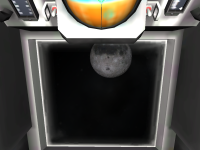 |
 |
 |
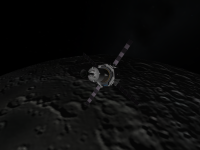 |
| Falling Moonwards | It looks big now… | Going lower | Over the terminator |
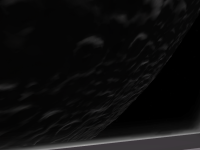 |
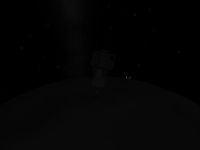 |
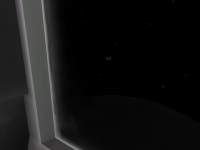 |
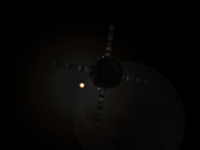 |
| A cratered surface | Earth rising | …indoor version | Out of the Shadow |
After the excitement of the fly-by, another 2½ day coast brought Wayfarer back to the depths of Earth's gravity well. A 230-second braking burn at 1847Z on the 26th, using most of the ERPS propellant, yielded a low Earth orbit of 420×347km, with a 0.03° relative inclination to the Station. (The trans-Earth half-orbit had been at 1°.) Orbital manœuvres over the next 21 hours guided Wayfarer back to a Station rendezvous.
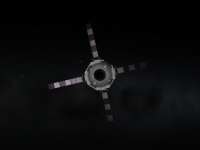 |
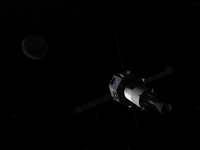 |
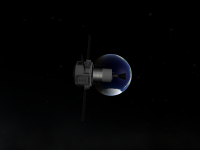 |
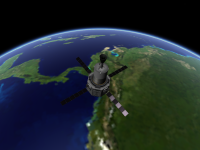 |
| An end-on view of Wayfarer | Leaving the Moon behind | Our view of Earth grows | Getting near to perigee |
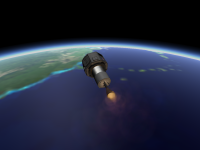 |
 |
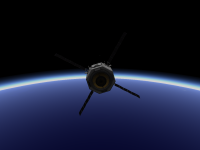 |
 |
| Braking burn with the ERPS | In LEO once more | The Station as tiny dot | Getting nearer to Station |
On the 27th, at 1600Z Wayfarer made its rendezvous with Lagrange Space Station; velocities were matched at 1605 and docking achieved at 1609. A quick EVA later and Brian was back in the rear seat of Napier 2, where Arkady had been waiting patiently all week to ferry him home. The spaceplane undocked and left the Station's vicinity to prepare for re-entry.
Finally, just before the calendar turned over, it was time to re-enter the atmosphere and aim for the Cape. Napier 2 entered the atmosphere (KSP definition, 140km) at four minutes to midnight, crossing the Kármán line at four minutes past midnight on February 28th. After a descent that rarely exceeded 100m/s and never reached 1.5g, smooth as a road from orbit right down to subsonic, the spaceplane came down at 0032Z. We were about 380km short of CCAFS — not my best work, especially as it meant a water landing, but good enough.
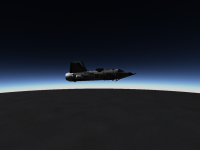 |
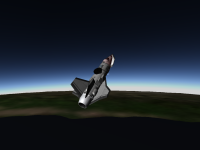 |
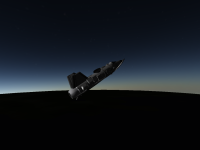 |
| With the nose flaps down | Pitching up at the coast | Using the small tail flap |
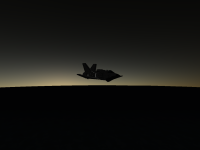 |
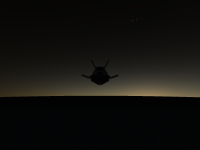 |
|
| Subsonic at Sunset | Nose-on Napier |
Future plans involve combining this architecture with a lunar-orbit propellant depot allowing a Delta Taxi to enter LLO and refuel for TEI and ERB manœuvres; eventually even having a fuelled-up lander at that depot is a possibility. Lunar-orbit propellant transfer has already been validated by the Laplace 6 lunar-sample-return mission, which refuelled both before and after visiting the lunar surface, ultimately being met in LEO by NEF-6, the Napier 1 being flown by Brian Newman.
While a lunar landing mission by this method would involve a large number of launches, it would be surprisingly inexpensive — capsules cost a lot more than taxis or spaceplane cockpits, and rollout costs scale quadratically as the GLOM grows (as a higher-level pad is needed), so a lot of Leibnitzes and Eulers can be fit in the same budget as a single Apollo / Saturn V launch.
However, it might be a while before I get to such missions, as I have a replacement Station to launch first, not to mention probes to send to planets and asteroids. I should be able to meet the Kennedy Deadline, though; it's only 1964 and I've basically got all the pieces except the manned lander proved in service.